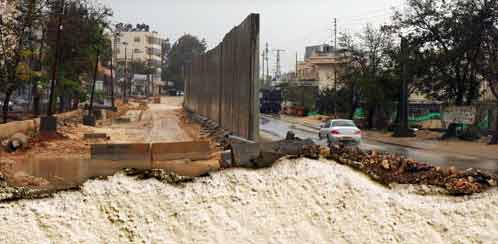Jerusalem Mayor’s first 100 days Marred by Discrimination Allegations
 Jerusalem Day
Jerusalem Day
by
Alison Prager
(See also our posting of the Acri Report on Jerusalem Mayor Barkat’s first 200 days, from which the photo above is taken.)
Thursday 21 May was yet another Israeli celebration: Jerusalem Day which celebrates the take-over and continued occupation of East Jerusalem, known here as the ‘unification’ of the city. Meir Margalit, Jerusalem City Councilor for Meretz and ICAHD (Israeli Committee against House Demolitions) Field Co-ordinator duly wrote to the Mayor with an account of his first 100 days in office. Obviously, not exactly complimentary, Meir Margalit, also spoke at a demonstration against the unfair allocation of the Jerusalem budget under Mayor Barkat.
I was asked to summarise the English translation of the letter, which was sent to consulates and the press with a comparative table of the amount of taxes spent on East and West Jerusalem. Please see below for the summary and the table.
Jerusalem City Councilor Dr. Meir Margalit has written to Mayor Nir Barkat with a scathing account of his first 100 days in office. Publishing budgetary allocations for both East and West Jerusalem, Dr Margalit states: “The rage rises and I fear an on-coming explosion.” The statistics Councilor Margalit has published clearly illustrate the stark inequality of the allocation system in Jerusalem’s Municipality, which he says far from improving the lives of East Jerusalem residents as Mayor Barkat promised, shows that nearly twice the amount of money spent on medical facilities and baby clinics goes to West Jerusalemites, as well as four times the amount on sports facilities and nearly five times the amount on libraries.
East Jerusalem residents who make up 36% of the residents of Jerusalem receive 7% of the budget while 64% of residents who are in West Jerusalem receive 92% of the budget.
Councilor Margalit also accuses the Mayor of trying to introduce new regulations concerning the contentious battle over the issue of building permits which could exacerbate the already discriminatory policies. A potential permit may only be issued when the applicant names heirs to the land. If a joint heir lives in the occupied territories the Guardian for Absentee Landlords has the right to claim the land on which the permit is sought as belonging to the State of Israel and then confiscate it. Councilor Margalit concludes that unless discriminatory practices are addressed “the future of Jerusalem is at stake.”
ALLOCATION OF MUNICIPAL RESOURCES EAST AND WEST JERUSALEM 2008
|
The whole city |
West |
East |
|
|
30,819,295 |
23,730,857 (77%)
45.2 |
7,088,438 (23%)
23.9 |
Budget for medical services in NIS
Budget per person in NIS |
|
29[1]
93,701 |
22 (75.8%)
56,104 (60%)
2,244 |
4 (13.7%)
37,597 (40%)
5,371 |
Baby clinics
(Children up to age 4)
Children per clinic[2] |
|
2189 |
1800 (82.2%)
291 |
389 (17.7%)
760 |
Trash cans per 7 Square meters
Residents per trash can |
|
460 |
400 (87%)
1,312 |
60 (13%)
4,930 |
Municipal sports facilities
Residents per facility |
|
26 |
23 (88.5%)
22,826 |
3 (11.5%)
98,616 |
Libraries
Residents per library |
|
53,363 |
40,784 (76.4%)
13 |
12,576 (23.5%)
23 |
Street lamps
Residents per street lamp |
|
|
92.6% |
7.27% |
Percentage of irregular (additional) budget |
|
|
19 (13.8%) |
4 (6.8%) |
Number of zoning plans accepted |
|
|
28 (20.4%) |
24 (41%) |
Number of zoning plans not accepted |
|
820,851 |
525,003 (64%) |
295,848 (36%) |
Population [3] |
[1] There are three clinics situated in the west that treat also children from the east and so they were not included in either sides of the city.
[2] The number of children per clinic includes both in the east and in the west the three clinics integrated clinics.
[3] The municipal statistics about population are devised not by east or west but by Jewish or not Jewish
